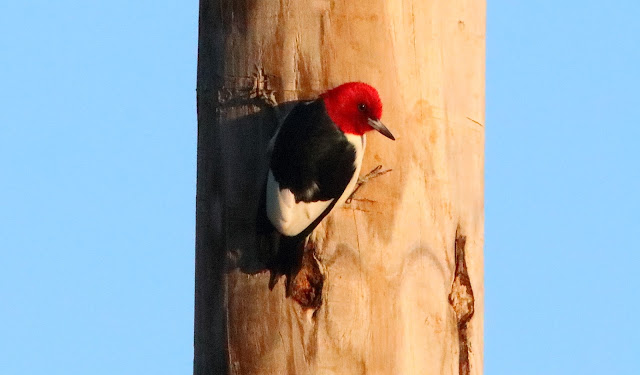Blog 6. Kansas!
male Yellow-headed Blackbird
I drive from Bartlesville,
OK, through the Tallgrass Prairie Reserve to Kansas, and spend the night at the
historic Wolf Hotel in downtown Ellinwood, KS. I am the only patron this
evening and have the whole Victorian second floor to myself (I am sleeping in
Room 1 and working in the upstairs dining room). It was there, among the
ancient photographs and bricabrac that I composed the last blog I sent out.
Hudsonian Godwits with artistic "backlighting"
The next morning I
returned to the flooded field, 4 miles to the east, where I discovered a group
of 30 Hudsonian Godwits the evening before when driving up from OK. This field
was much like the field I watched Hudsonian’s in Oklahoma, an unplanted stubble
field with standing water crossing much of it. The presence of Franklin’s Gulls
in numbers alerted me to the possibility of shorebird associates. In the
deepest water were flocks of Redheads and Blue-winged Teal.
Cliff Swallows collecting mud for their globular clay nests
I had studied the godwits
for about an hour the night before, which kept me from getting to my planned
campsite at Cheyenne Bottoms (hence the surprise stay in the ancient hotel).
The predicted arrival of the night’s rain also discouraged me from setting up
camp that evening.
Western Willet showing his stuff
The next morning I returned
to observe and photograph the godwits at the field to the east. Conditions were
poor (dark and gloomy, with wind). I wandered in tall boots trying to approach
the birds, but without success…
Eastern Kingbirds were abundant in the fields, recent arrivals from south
I retreated to Granny’s
Kitchen in Great Bend, KS, for a palliative home-cooked breakfast featuring
hand-made corned beef hash and sourdough bread. This was very fine. This tiny
establishment on the edge of town is a favorite of those living in this farming community.
flock of White Pelicans
I then visited the Kansas
Wetland Education Center on the east side of Cheyenne Bottoms, and got some
intel on possible shorebird sites (turned out not to be helpful). The high
water has made shorebird habitat minimal in the Reserve.
Black Tern
After an hour touring the
dikes of the massive circular shallow lake, I made my way to the campground,
which was little more than a grassy expanse under a line of ancient Cottonwoods
next to a slim strip of woodland out in the open expanse of fields and
prairie—with Cheyenne Bottoms lake just to the east. Here I had ready access to
the Bottoms, but little else. Amazingly, I had good internet service and could
send and receive emails (I was 3 miles south of Hoisington, KS).
resting flock of Black Terns
The Bottoms at the time
of my visit has no shorebird habitat. It is, instead, habitat for scores of
friendly Black Terns, working their way back and forth along the channels by
the dike.
Black Terns on the East
Coast are uncommon and rarely seen in numbers. Here I could find 30 perched on
a metal railing (below).
line of Black Terns
White Pelicans also
frequent the waterways. Soaring overhead, they are huge and graceful…
The next day I return to the godwit field to find no birds of any kind, and then after another
obligatory visit to Granny’s Kitchen I traveled south to Quivira National
Wildlife Refuge, another reserve famed for its shorebirds. Not much, though, this AM.
A pair of
Upland Sandpipers in a barren farm field was the highlight on the shorebird
front (actually, on the “grasspiper” front).
Female (back) and male (front) Wilson's Phalaropes (Female is the bright one!)
The landbird highlight
was 24 Red-headed Woodpeckers working the roadsides, flying gracefully with
their marvelous white wing and back patches, shining in the sun.
Red-headed Woodpecker, loving the telephone poles to death
The surprise bird of the
day came from the verge of the campsite woods—several Harris’s Sparrows coming
out of the thickets to feed on seeds along the edge of the dirt road of the campground.
Harris's Sparrows
The next morning I set up
my folding chair near the section of the camping area frequented by the
Harris’s Sparrows and waited, not long, and out they came to forage. For East
Coasters and West Coasters this is a special bird. They winter in the southern
heartland and breed up in the far north of Canada.
Harris's Sparrow
The next day (13 May) I
depart for Nebraska. I say farewell to the shorebird-free Cheyenne Bottoms
and head for parts north. Driving north on route 81 in north-central Kansas,
zipping along at 75 mph, out of the corner of my eye is a flooded field and
three large birds.
Harris's Sparrow
I stop to photograph
three Hudsonian Godwits, just south of Minneapolis, KS. I see one dip its beak
deep into the water and draw out a 7-inch worm. It skitters away from the other
two to avoid a theft of a tasty morsel.
Hudsonian Godwits seen from highway 81 at 75 mph
I’ve been on the road for
23 days and now have tallied Hudsonian Godwits on 6 of the last 7 days, and
have counted 248 bird species total. Twenty-three species of shorebirds
(Scolopacidae), and 26 species of wood warblers. Next stop, Nebraska, the Corn Husker state.
Snowy Plover

















No comments:
Post a Comment